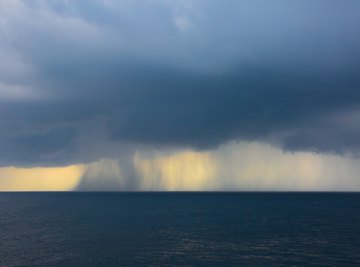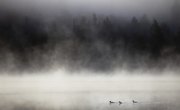
Certain kinds of precipitation are associated with summer weather conditions and other forms are associated with winter weather conditions. The form precipitation takes when it falls to the Earth's surface depends on the temperature of the air both in the clouds and at ground level. Precipitation falls to Earth in the form of snow, graupel, sleet, hail, rain or fog drip.
Identification
Precipitation is any condensed water vapor that falls to the surface of the Earth. According to the Weather Channel's Storm Encyclopedia, all winter precipitation begins as frozen water vapor in the clouds regardless of what form it becomes at ground level. Associated with winter, snow and graupel fall as frozen precipitation. Precipitation associated with summer weather includes rain and hail. Other forms, such as drizzle, sleet and fog drip, are not necessarily seasonal-relative.
Rain
Rain, the most common form of precipitation, consists of water droplets that have become heavy enough in the clouds to fall to the Earth's surface. Meteorologists use different terms to describe the rain droplets. For example, drizzle is generally light steady rain. Sprinkles are raindrops that fall in fine drops and usually for short periods of time. Rain occurs in all seasons, depending on the temperature in the clouds, the atmosphere and at the ground level. Freezing rain occurs when water droplets go through a layer of cold air before hitting the ground and freezing upon contact.
Snow
The most common type of frozen precipitation is snow. Temperatures below freezing from the cloud levels to the ground are conducive to precipitation in the form of snow. Water vapor freezes into ice crystals at the cloud level and falls to the surface of the Earth in flakes when the ice crystals become too heavy to remain suspended.
Sleet, Hail and Graupel
Sleet and hail are similar forms of precipitation. However, hail is generally associated with thunderstorms or summer weather conditions and precipitation in the form of sleet is more likely to occur during winter-like weather. Sleet is partly frozen rain, and precipitation in the form of hail is basically ice balls. Graupel is formed from ice-coated snow crystals that fall to the Earth's surface. After falling to the ground, graupel is generally called snow pellets.
Fog Drip
A cloud of condensed water vapor suspended in the air near the surface level of the Earth is called fog. When the water droplets become too heavy to remain suspended, the droplets fall to the ground in the form of fog drip. This form of precipitation originates from condensation in the atmosphere.
References
- NOAA: NWS JetStream - Precipitation
- "Science 101: Weather"; Trudy E. Bell; 2007.
About the Author
Vicki A Benge began writing professionally in 1984 as a newspaper reporter. A small-business owner since 1999, Benge has worked as a licensed insurance agent and has more than 20 years experience in income tax preparation for businesses and individuals. Her business and finance articles can be found on the websites of "The Arizona Republic," "Houston Chronicle," The Motley Fool, "San Francisco Chronicle," and Zacks, among others.
